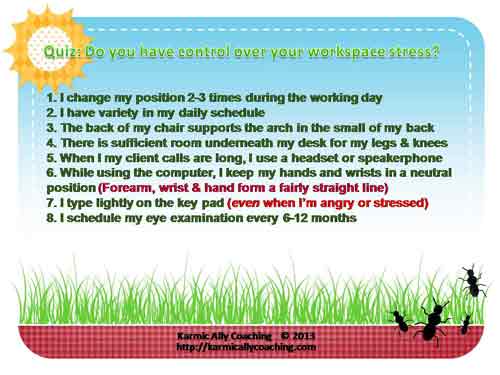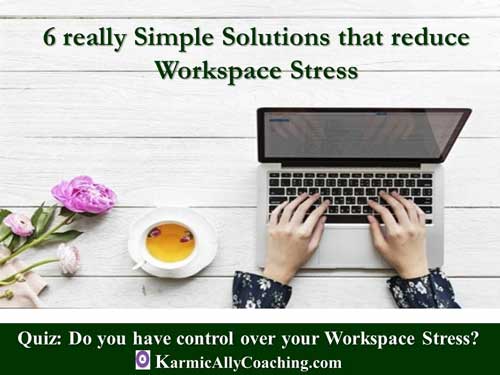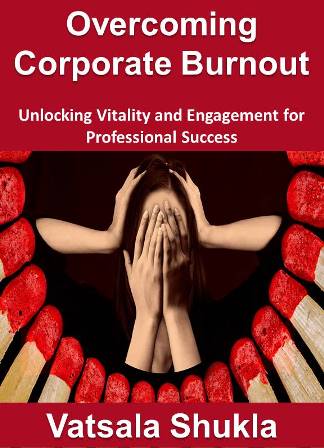Workspace stress is a real phenomenon that needs to be addressed.
I had my second tryst with a slipped disc injury in 2011 when a BPO van hit my car. The rear end of my vehicle required denting and painting. But the real damage was the resulting jolt to my back, a slipped disc and many painfully frustrating weeks recuperating.
At the time, the good orthopedic surgeon told me to take comfort from the fact that considering my age group, my back was doing well otherwise.
It appears that back problems, herniated discs and posture problems are increasing among the 21–35-year age group due to the workplace environment.
I thought he was being kind but recently, my neighbor’s 21-year-old daughter who has just joined the workforce is down with a back problem and complete bed rest. Her mother tells me the workplace environment is stressful and her recent ailment a direct result of sitting at her desk the whole day.
When it comes to workspace stress, we may not be able to control everything in our workplace environment
Yet, we DO have control over our workspace environment.
That control can help in keeping off some of the stress and maintaining good health. So here is a quiz that I use in my Stress Management Coaching.
Look carefully at the 8 questions on the slide and respond with a Yes or a No.
If you feel it is a Maybe/Sometimes, just treat it as a No. Give yourself 1 point for each Yes and 0 for each No or a feeling Maybe/Sometimes and then tally your score.
There are no right or wrong answers just facts so be honest and help yourself to you!

Workspace Stress Quiz
Workspace Stress Quiz Scoring
8 Yes – Excellent, you don’t need to read further but can help others by sharing this post
7 Yes 1 No – Well done. Check below to see what you need to do to get 8 Yes and share the post.
6 or less Yes – You need to start taking stock of your workspace. Check the tips below.
8 No – PLEASE stop in your tracks and take serious control of your workspace before your stress levels increase and health deteriorates.
6 really Simple Solutions that reduce Workspace Stress

1. & 2. Fatigue sets in when we are in the same position throughout the day.
Alternate your tasks during the day so that your body does not get stressed out. If you have a predominantly desk job, make it a point to get up for 5 minutes every hour and get some movement into your schedule. Take a walk to the photocopier or get a glass of water.
Sounds difficult?
How about getting up from your seat and just stretching with your arms above your head? Incorporate movement into your day by alternating tasks and avoid fatigue by improving your blood circulation.
3. Adjust your seat first thing in the morning to ensure that there is a better fit for the lower area of your back.
Even if you have to go another room for a meeting, adjust your meeting chair to feel comfortable. It will ensure that you are able to focus more on the meeting and less on your discomfort. Consider investing in a good lumbar pillow.
4. The area under your desk is not a storage area and you need to clear out materials, bags, files and papers.
Your legs and knees too need space! Your thighs should be able to go completely under the table. Also consider lowering your chair so that your legs do not hang in air.
5. Cradling your phone/mobile between your shoulder and head will give you neck problems.
Consider putting on the speaker phone or if that is not possible a phone head set.
6. & 7. Avoid stressing your wrist by making sure that your forearms, wrist and hand form a straight line.
If required, adjust your chair and keyboard. Excessive use of the computer with wrong positioning of your hands can lead to carpal tunnel syndrome– which is quite painful.
Increase the life of your keyboard and be kinder to your fingers and hands by typing gently. Attacking the keyboard won’t get the work done faster, so don’t take your anger and stress out on the keyboard!
8. If you use the computer excessively for your work, make sure that you schedule an eye exam every 6 months to make sure that your power has not increased.
Remember to tell the eye professional your age and the amount of time spent in front of the computer. Both are factors in determining if you need glasses and if so, the right power. Your reading power might not increase but constant use of the computer may require correction to your lens.
Do you have any techniques of your own to handle workspace stress?
Long term stress contributes to burnout. Game to take another assessment and find out if you’re heading for a burnout?
Update 18 July 2024 – Overcoming Corporate Burnout
Burnout is real and considered by WHO as an occupational phenomenon that can lead to serious mental and physical health concerns.
I’ve been hearing from colleagues about burnout and that inspired me to start writing about it.
The end result is Overcoming Corporate Burnout: Unlocking Vitality and Engagement for Professional Success.
As a professional who’s had to face burnout and survived, this is my endeavor to share what works.
Inside this burnout prevention and recovery book, you’ll learn:
– The key signs and symptoms of corporate burnout and how to recognize them early.
– Proven techniques to manage stress and maintain a healthy work-life balance.
– Strategies to enhance your mental and physical well-being, boosting your energy and focus.
– How to create healthy boundaries to guard your space and time and avoid being overwhelmed.
– Ways to increase your engagement and productivity, ensuring sustained professional growth.
Now it’s your turn to learn the basics to prevent burnout and start your road to recovery if you’re already experiencing burnout.
The book is available across all Amazon markets.
Written By: Vatsala Shukla






 I adhere to the Certified Coaches Alliance Code of Ethics and Standards. A copy is available on request.
I adhere to the Certified Coaches Alliance Code of Ethics and Standards. A copy is available on request.
 Let's Talk through the Connect Form:
Let's Talk through the Connect Form: